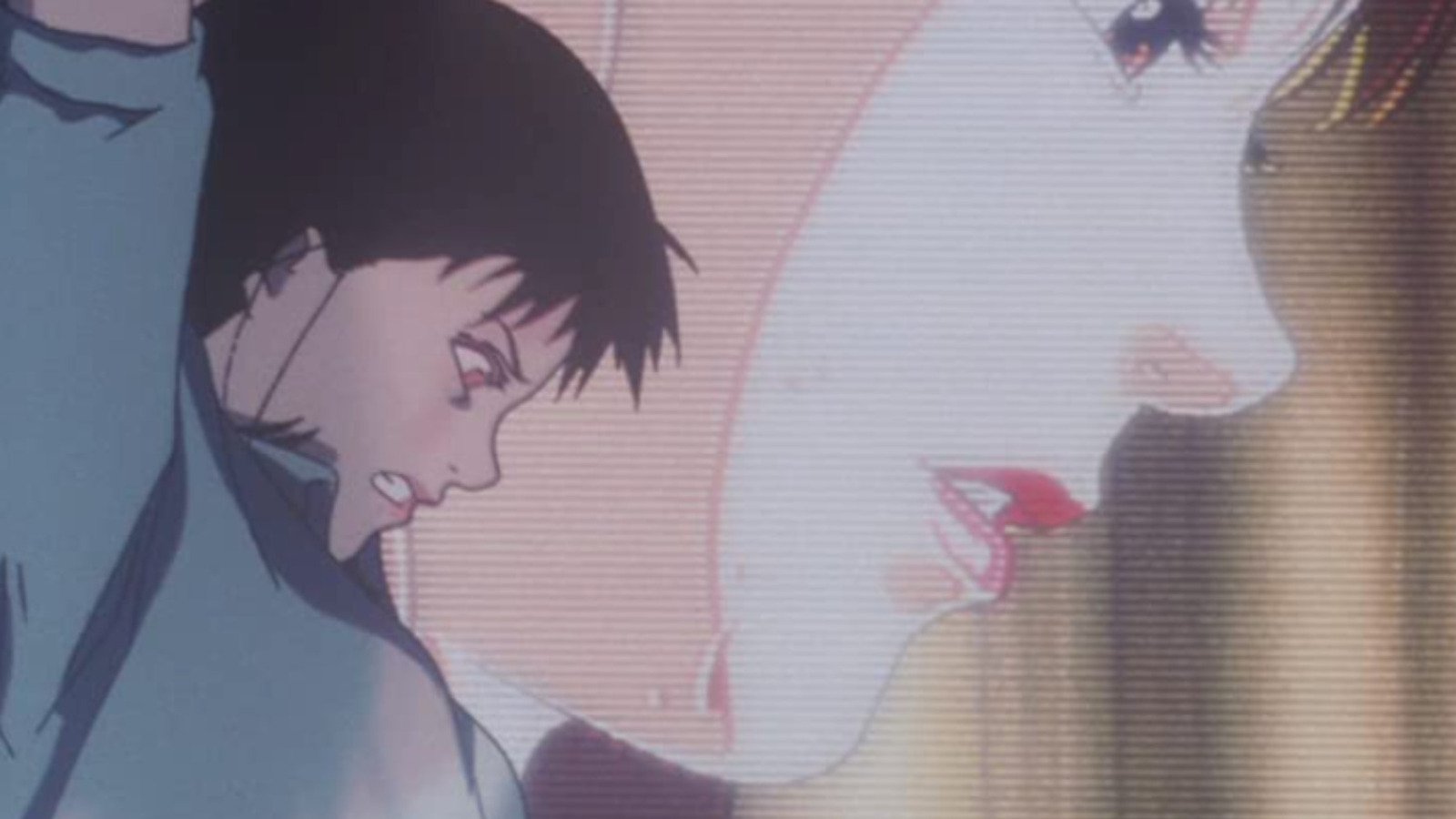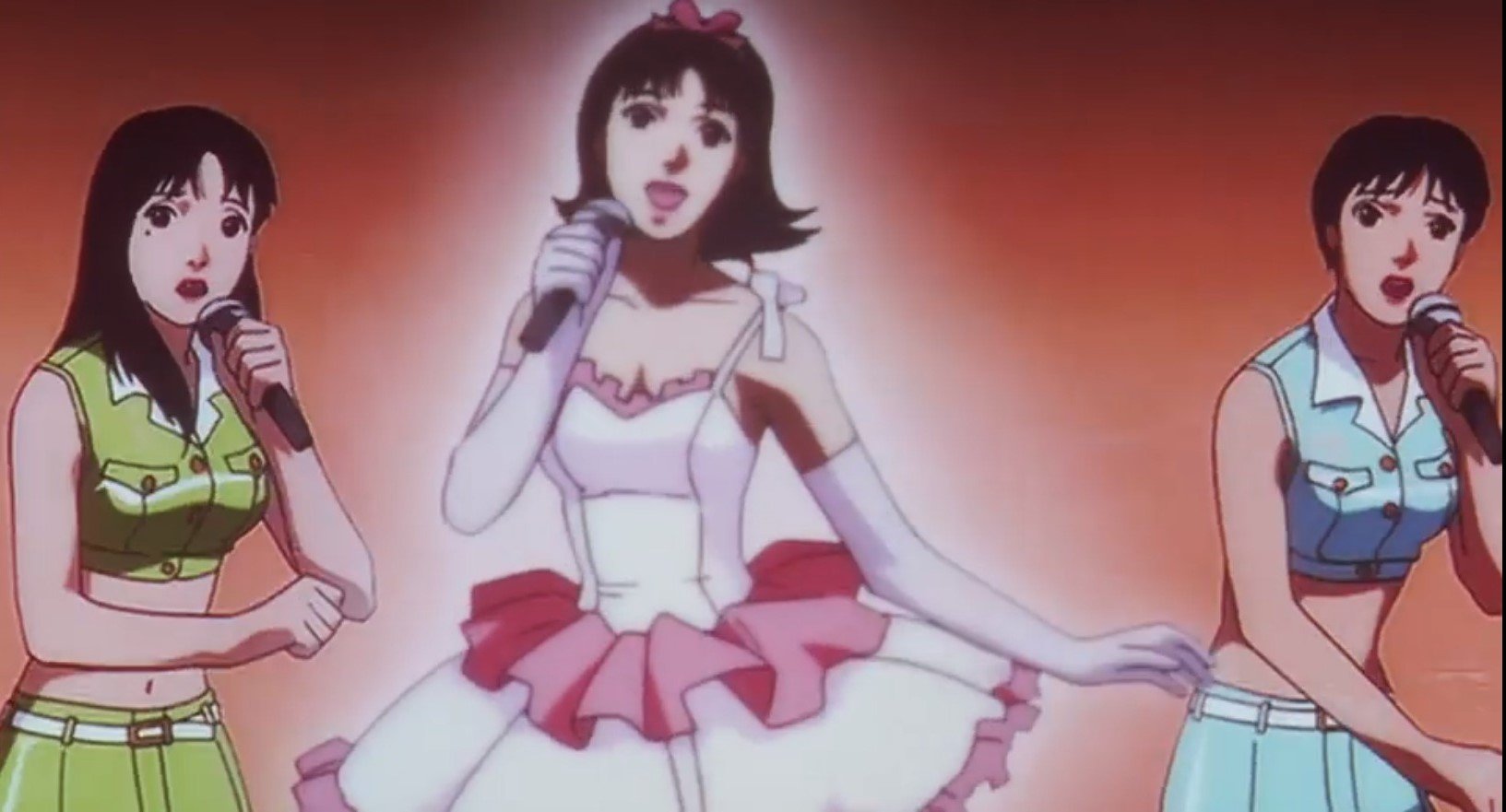Surreal Idol
BEWARE SPOILERS
At long last, we’re wrapping our Dissection series on animated horror. And we’re going out with one of our favorite films of all time, Satoshi Kon’s Perfect Blue (1997). As always, we go into these deep-dives assuming you’ve already seen the movie being discussed, so if you haven’t, and if you hate spoilers, now’s the time to check it out. We’ll be here with all our juicy, spoilery analysis when you get back.
In 1997, Satoshi Kon brought us the visually stunning and emotionally complex psychological thriller, Perfect Blue, adapted from Yoshikazu Takeuchi’s novel, Perfect Blue: Complete Metamorphosis. Kon’s film, a masterpiece of anime, horror, and drama, tangles audiences in the psyche of Mima (Junko Iwao), a J-pop idol ready to shed her innocent persona with the girl group CHAM! and prove herself a serious actress.
Over the years, the film’s enjoyed a lot of well-deserved love. Polygon’s Mary Beth McAndrews admires this story about a young idol struggling with her identity and public obsession with her celebrity and comments on how, twenty-five years later, we see the film as having predicted the descent of many modern fandoms into the toxicity that online spaces enable. Briana Luck at Mxdwn.com adds that the movie predicted the internet’s destructive effects on identity, raising new and troubling questions over who owns a star’s public persona, leading to pervasive voyeurism, a monolithic male gaze across media, and entitled, dangerous fans.
In short, Kon predicted all the terrible things we would do to each other with this newly mainstream “World Wide Web”: voyeurism, objectification, stalking, identity theft, intimidation, dehumanization, and in some cases, violence and murder—because no species commits terrible atrocities upon itself like humanity.
Chris Lambert provides a thorough breakdown of the movie at Film Colossus, pointing out eerie parallels between Mima’s story and the real-life story of beloved Mexican-American singer Selena Quintanilla-Pérez (known as a global celebrity by her first name, Selena), who died at the hands of her agent, Yolanda Saldívar, a fan whose obsession drove her to murder. Lambert notes that the relationship between Mima and her manager, Rumi, at times mirrors “the relationship between Yolanda and Selena,” who's murder happened the same year Perfect Blue came out.
Selena’s isn’t the only story reflected in Kon’s film. Uchida/Mr. Me-Mania echoes Mark David Chapman, the obsessed fan who gunned down John Lennon outside his home in New York. Chapman sympathized with Holden Caulfield’s rage at “adult hypocrisy” in JD Salinger’s novel The Catcher in the Rye. He grew so disillusioned by the discrepancies between the public persona of John Lennon, who preached idealism and beauty in songs like “Imagine,” and the private person of John Lennon, who abandoned his first family, lived a life of luxury, and had a history of beating the women in his relationships. Believing his idol had fallen from grace, Chapman murdered Lennon because he couldn’t reconcile the reality of a flawed human with the saint-like persona Lennon had crafted.
Perfect Blue depicts toxic celebrity culture, voyeurism, objectification, and the fragility of identity in a cautionary tale about the dangers of uncritical immersion and escapism in media fantasies made to feel like separate realities.
The Alienation Effect
The film uses several techniques to accomplish what German playwright Bertolt Brecht called “Verfremdungseffekt.” In English, the “alienation” or “estrangement effect.” These days, we boil the idea down to “breaking the fourth wall,” in which the performers and the work itself acknowledge and speak directly to the audience in some way. There’s more to it than that, though.
In a happy accident, Brecht’s misunderstanding of Chinese theatre delivered a powerful change in how he saw theatre in general. He wanted stories to remind viewers they're engaged with constructed fantasies, to separate themselves from these fantasies and break the spells of immersion and suspended disbelief. These, according to Brecht, muffle the audience’s ability to think critically about the people and scenes before them.
Escapism, immersion, suspension of disbelief, method acting, meticulous realism in props and sets: to Brecht, these are the tools of “bourgeois theatre.” Society uses those tools to try to convince us that all of humanity behaves in the way our actors are representing onstage, as if the “Black man loves in the same way as the white man.” To Brecht, this kind of art erases difference across human experience and whitewashes our view of what it means to be human. It pushes us to accept the narratives of a capitalist society guilty of bigotries, injustices, and atrocities, to accept and therefore support the very social structures that harm us.
How does a play (or a film or short story or videogame or whatever) jar the viewer back to critical reality when they start to lose themselves in uncritical fantasy? Well, Brecht encouraged detachment from his performers, rejecting the idea of method actors embodying their roles and evoking empathy in favor of a more objective style of play-acting that instead fueled curiosity. Brecht would also use harsh lighting, relatively bare sets, and minimal props. He’d make things like stage lamps visible to the audience, interrupt the action in the narrative with songs to emphasize a key point, and use the equivalent of title cards to explain certain things.
Modern-day playwrights, film and television creators, videogame designers, and other artists still use Brecht’s tools. Director Spike Lee, for example, uses title cards to explicitly tell viewers the reality behind the fantasies depicted in his movies. Actors in Lee's films often turn and speak directly to the camera about the themes, ideas, and histories being explored. Films like Scream (1996) and Cabin in the Woods (2011) speak openly and critically about the very tropes, archetypes, and stereotypes they themselves indulge in.
Perfect Blue alienates audiences, pulling them out of their immersion and suspension of disbelief. And when you distance yourself and question what’s shown onscreen, the way the film wants us to, the nature of its own narrative changes. Events cease to be real or fantastical. Instead, everything in the story is surreal, and this surreality isn’t just in the characters’ heads. Reality and fantasy collapse around Mima in a metaphor for the dangers of escapist art. Perfect Blue warns that fan obsession and fantasy indulgence can lead to shared delusion, the erosion of identity, and the collapse of the real and the fantastic.
The Popular Interpretation of Perfect Blue Is Wrong
Perfect Blue constantly reminds audiences we’re watching a movie, that we’re meant to engage with it critically. In fact, if you give yourself over to it completely and accept what’s presented onscreen as reality vs. fantasy, it doesn’t make sense—or at least, not very good sense.
The popular and mistaken understanding of the film says there is a reality, in which Mima is a person seeking a career change, and there is a fantasy, in which Mima is a chaste and perfect pop idol whose image is sullied by the lurid world of acting. This take on the film says 1) Idol Mima is a fantasy, 2) the real Mima is having an identity crisis brought on by toxic fandom, 3) two people obsessed with the fantasy begin to stalk Mima and steal her identity, and 4) those people try to kill anyone who corrupts the fantasy, including Mima herself.
This reading requires you to suspend disbelief and ignore at least one glaring plot hole—which the very critics who hold to this understanding of the film openly acknowledge. Film Colossus' Chris Lambert ruminates on the CHAM! performance in the middle of the film. “Mima” makes a surprise visit, at first shocking and then delighting her fans. Lambert writes, “There’s an eerie white glow around Mima,” as if she were a ghost or spirit of some kind. We know this isn’t the “real” Mima, but who is it?
There’s no indication that it’s a hologram. Lambert notes that Rei and Yukiko’s expressions of surprise and concern tell us we’re not seeing a mere hallucination from Mima or Mr. Me-Mania. He suggests the most likely culprit is Rumi. The issue with this, though, as Lambert himself points out,
is that no one ever questions Rumi about it. Tadokoro never brings it up. The CHAM! girls don’t bring it up. And wouldn’t someone notice that the older, portly Rumi didn’t look anything like the young, slender Mima? It’s all kinda confusing. And there’s no real right answer for it.
Except, there is an answer—if we accept the film’s surreality.
See, that “eerie white glow” says there’s something more going on than a delusional Rumi adopting Mima’s persona onstage. Idol Mima is the result of collective obsession with a fantasy, the product of a belief shared by Rumi, Mr. Me-Mania, and other fans who see her as the “real” Mima. Their obsession disturbs the line between fantasy and reality, giving birth to Idol Mima.
Perfect Blue is a fantasy about perceived realities in conflict with each other—where no reality seems quite right because no reality is quite right. Everything becomes clearer when we actively question the characters’ assumptions about reality and fantasy. The strange events—Idol Mima's spectral guest appearance with CHAM!, Mima’s warped perception of time and identity, even Rumi's transformation into Idol Mima—are just as “real” and “true” as when Rumi impales herself on broken glass. In the film’s surreality, truth and fantasy are inseparable.
Conceived by an obsessed fandom, Idol Mima uses the “Mima’s Room” website to grow, to fuel Rumi’s delusions, to possess her, and to drive Mr. Me-Mania’s murders and attempted assault. Idol Mima first comes into physical existence when Mima, to Rumi’s horror, agrees to film the rape scene in Double Bind. Riding the subway, Mima glances at her reflection in the window and sees Idol Mima, who declares, “I absolutely REFUSE to do it!”
The standard reading of the film agrees with Rumi’s doctors at the end, who say she suffers from DID and tried to murder anyone who threatened her fantasy. This is partially right, but it hand-waves all kinds of stuff, including the part where Idol Mima appears onstage after Mima has left the group. You can say Rumi develops DID, but for the plot to make sense, Idol Mima has to be more than a fantasy. And if that’s the case, then it’s simpler and more straightforward to say that she has possessed Rumi and caused what the doctors call DID.
Consider the big showdown between Rumi and Mima. Rumi only looks like herself when in physical peril (being strangled, impaled, stumbling into the street), when we see her in reflections, and when Mima tears her wig off. Otherwise, we see Idol Mima gliding easily after Mima with supernatural grace. One explanation might be that we’re seeing Mima’s hallucination, but dialogue shows she clearly recognizes Rumi as Rumi. Another explanation is that we’re seeing Rumi’s hallucinations; but then it wouldn’t make sense for her to see herself (rather than her hallucination) in her reflected image. Instead, she sees Idol Mima in the mirror only at the end of the film, in a mental hospital, after Idol Mima has possessed her body and destroyed her sense of self.
It’s All a Fantasy About a Surreality About the Realities of Collective Delusion Fueled by Escapist Fantasies
Double Bind, the television show in which Mima is guest starring to launch her acting career, often mirrors the terrifying story unfolding in “real” life. During one confusing and alienating sequence of scenes in the second half of the film, Mima’s senses of time, self, and reality all get thrown into question. The Double Bind crew is shooting a scene in the rain, and Idol Mima has been taunting and threatening to take over Mima’s life. The protagonist in Double Bind tells Mima’s character, “It’s alright. There is no way illusions can come to life.” Mima then spots Mr. Me-Mania on set and flubs the take.
Later, Mr. Tadokoro takes Mima to visit the CHAM! girls, and Mima freaks when she sees Idol Mima sitting between her former colleagues while the girls are hosting their new radio show. Idol Mima laughs and skips away, and Mima gives chase until she’s in the middle of the road and an oncoming truck (with Mr. Me-Mania as the driver) is about to hit her. Then the scene cuts away, and what follows is generally regarded as the film’s most confusing sequence. First, I’m going to lay that sequence out. Then I’m going to explain what the hell is happening in it:
Take One
Mima awakes in her bed. On the TV is a news story about “the Economic Planning Agency” and “a ‘New Citizen’s Life Index.’” Rumi shows up, and the two of them talk over tea. Mima says it’s been a while since she’s seen Rumi, who replies that she’s been busy. Mima expresses concern that she, like her character on Double Bind, might have another personality that’s acting out on its own and hurting the people around her who are leading her to perform in scenes that involve sex, rape, and other “blue” material unbefitting her idol persona. During this conversation, we transition to the set, where the Double Bind crew is filming the same scene from yesterday (this time without the rain). Like before, Mima spots Mr. Me-Mania in the crowd, but he’s gone when she glances back over. Then the Director shouts:
“Alright, take two!”
Cut back to Mima as she awakes in her bedroom. The TV spouts the same news about “the Economic Planning Agency” and “a ‘New Citizen’s Life Index.’” Rumi visits again, the two have tea again, and Mima finds herself unable to distinguish yesterday from today. She’s not even sure whether yesterday happened or if today is currently happening. When Mima once more says it’s been a while, Rumi responds that she just visited yesterday. Of course, this does nothing to settle Mima’s inner turmoil, and it doesn’t seem to be accurate, given the eerie repetition of the same news story and the same conversation. Mima grips her teacup so tightly it shatters in her hands and cuts her palms. That night, Mima reads on “Mima’s Diary” that she “went shopping in Harajuku” because she’s “a sucker for sale items.” She doesn’t recall, but with resigned exhaustion she mutters, “I guess… I went to Harajuku today.” We then pivot to a scene from Double Bind, where we learn that Mima’s character, Yoko, suffers from dissociative identity disorder (DID), that she created the illusion of a murderer in her head and then acted out his crimes. When one character says, “But illusions don’t kill,” the other replies, “What if that illusion found someone to possess?”
From there, we see a killer disguised as a pizza delivery person—presumably Rumi possessed by Idol Mima—murder the photographer from Mima’s nude shoot. As he dies, we get flashbacks to the shoot interspersed with the sight of Mima repeatedly stabbing someone as her character in Double Bind. The fantasies Mima performs on camera are being reflected in the events surrounding her life. Fantasy, we’re being told, is invading reality. Then the Director calls out,
“Alright, take three!”
Mima wakes for a third time in her room, staring at her trembling hands. We don’t know whether those hands are trembling because they hurt from that shattered teacup or whether they’re trembling because she’s lost her sense of reality, but it’s not long before news of the photographer’s death reaches her and she finds bloody clothes stashed in her closet.
On set, Mima’s told to breathe harder than she did in rehearsal. After all, her character has just killed someone. The Director yells,
“And … action!”
Yet again, Mima wakes up in her room. This time we flash forward to the Double Bind set. While filming, when Mima’s character, Yoko, is asked if she knows who she is, she replies, “Mima Kirigoe… I’m a pop idol. No… an actress.”
The line prompts the other Double Bind characters to discuss the condition of Mima’s character, specifically how her dissociative identity disorder manifested from the trauma of being raped at the scene in the strip club. Mima, in character, says, “That’s right. I’m an actress,” and the Director:
“Cut!”
Notably, the scene the production crew has just filmed changes slightly when they rewind and watch the tape. Here, Mima’s character calls herself Rika Takakura and claims “she’s a model.” Discussion about the character’s DID still follows, but we get a new line about her “killing, and later becoming, her sister the top-model.” Mima’s character—Yoko or Rika, who knows?—says, “That’s right. I’m a model,” and the Director announces, “That’s the take!”
After Double Bind wraps, Mima calls her costar Eri by her character’s name when they run into each other in the hall. Eri tells her to remember that illusions can’t come to life and, weirdly, that Mima “should stop dreaming soon.” Eri’s exit brings about Mr. Me-Mania’s entrance, and as he advances on Mima, the film cuts to Rumi, talking outside with Mr. Tadokoro. He says Mima’s upcoming starring role will feature more sketchy scenes and climbs into his car. His headlights bathe Rumi in an eerie glow reminiscent of Idol Mima glowing onstage between her CHAM! costars.
Mima, meanwhile, is attacked by Mr. Me-Mania in the same place she acted out the rape scene. When she kicks him off, he chastises her for not following the script and shouts, “And now…Take 2!”
A fight, complete with anime music, ensues, ending when Mima slaughters Me-Mania with a hammer. Then the Director’s voice, one last time:
“Okay, looks good!”
The sequence closes as Mima stands under stage lights in front of a clapping, cheering audience that also seems to not be there.
This sequence of scenes feels disjointed. No matter how you piece it together, it makes no chronological sense, and there’s no way to distinguish Mima’s perception from reality. Writing these off as mere plot holes, as viewers are sometimes prone to do, seems too easy and hasty for a film so meticulously crafted. The other way viewers generally account for the disjointedness and muddled perspectives is to handwave them away as hallucinations. To some extent, this works, but then you’re still left to account for Idol Mima’s performance with CHAM! earlier in the film, in which she would have to be a shared hallucination for everyone at the event and everyone watching on television. If you go that route, all that’s left is to start cherry picking who you think is hallucinating when, which isn’t an especially satisfying or thoughtful approach.
Instead of assuming these scenes are plot holes or hand-waving them away as hallucinations, assume they’re intentional and meant to push you to think about the film’s themes, to inform your understanding of the events of the movie.
Once Idol Mima is brought into existence, dream logic begins to overtake the world of Perfect Blue. Our perception of time and space and reality, in this sequence of scenes and elsewhere in the film, is warped because the line between fantasy and reality has been violated by masses of fans who have willed, by sheer obsession, the fantasy of Idol Mima into reality.
Whereas a story aiming for realism and immersion normally focuses on plot and character to develop themes, in Perfect Blue, the themes explain what’s happening in the plot and to the characters. Idol Mima serves as a metaphor for the real-life dangers of escapist art. She’s the thematic embodiment of loss of identity, murderous obsession with a narrative, and dissociation from reality. These dangers are ever more present in the internet age, when everyone, including crazed fans, has access to tools that enable stalking, intimidation, harassment, objectification, and dehumanization.
When I say the film is about the dangers of escapist art, of losing yourself in a fantasy, of dissolving the line between fantasy and reality, I mean that those dangers come to literal life in the movie. Idol Mima isn’t just a fantasy. She has real power in the world of Perfect Blue. She actually speaks to Mr. Me-Mania. When all those posters of Idol Mima come to life while he’s at his computer in “Mima’s Room,” that’s not a hallucination. Idol Mima actually possesses Rumi and drives her to madness and murder.
“No, I’m real!” (No She’s Not)
Mima, contrary to her claim at the end of the film, “No, I’m real!” is, in actual fact, a fantasy. She’s a character in a movie called Perfect Blue, no more or less real than Rumi, no more or less real than Idol Mima. I know this might seem irrelevant, seeing as it’s true of every character in every piece of media. But, as I’ve pointed out, Perfect Blue draws specific attention to this fact several times throughout the film, and that’s not an accident. Characters repeatedly tell Mima that she’s dreaming, that she should wake up, and that illusions can’t come to life, while the events onscreen show us that Mima is both awake and dreaming, and that illusions do come to life.
These are all very intentional reminders that audiences are watching a constructed fantasy, a dream in which anything can happen. We’re being jarred out of the story, out of our ability to immerse ourselves in it. The film is telling us to wake up, to maintain the separation of fantasy and reality threatened by obsessive fans with access to reality-bending internet tools and by media increasingly geared toward immersive experiences that alter our perceptions of reality and fantasy.
Think of “No, I’m real!” as the horrific reverse of Rene Magritte’s caption to “The Treachery of Images.” The French painter’s best-known work depicts a smoking pipe and, below it, the words, “Ceci n'est pas une pipe.” In English, “This is not a pipe.” Instead, “The Treachery of Images” is a fantasy insisting to audiences that it is a fantasy, just paint on a canvas made to resemble a pipe. Mima, on the other hand, is a fantasy (of an anime character) insisting to the film’s audience that she is real, as her car’s rear-view mirror reflects her gaze straight into the camera.
That mirror is like a different sort of theatrical fourth wall. The character has three walls around them onstage, and in realistic performances, they’re supposed to pretend there’s a fourth wall between them and the audience. In this case, Mima appears to be looking directly at the audience, but she’s actually doing so indirectly through her reflection, a double of herself, while also insisting on her own reality.
This is one of the goals of the alienation effect, to get audiences to feel and think about a scene differently from how the character being portrayed thinks and feels. Mima’s final line, from the audience’s perspective, should mean exactly the opposite of what Mima thinks it means. She’s not real. None of this is. It’s all a surreality from which she will never escape. Because, you know, it’s a movie.
Perfect Blue uses surrealism as an alienation tactic and Idol Mima as a metaphor for the dangers of uncritical immersion in media, of obsessive fandom, of art as pure escapism, of merging fantasy and reality. All of these can work to corrode the human psyche. We’re fragile creatures and kind of stupid. All of us, including the Einsteins of the world, perform elaborate works of self-trickery that can damage our senses of identity and truth, erode our compassion for other beings, and leave us susceptible to all the madnesses of a world filled with screens reflecting endless streams of immersive fantasies and competing realities.











